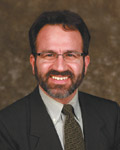February 2, 2011
Can’t Read the Fine Print?
 By William Benevento, M.D.
By William Benevento, M.D.
Eye Surgeons Associates
Presbyopia. Everyone beyond the age of 40 or so experiences it. We cannot focus on things up close, so we push our reading material farther back until our arms are fully extended and the print is still out of focus. For many people, this prompts their very first visit to an eye doctor.
Presbyopia, or “old eyes,” refers to this difficulty with reading vision. It results from a loss of the eye’s ability to accommodate, the process by which we bring a crisp, clear distance focus point up near. When we are looking in the distance, the lens inside the eye is relaxed. When we look at something up close, a muscle contracts and the lens changes shape and position, increasing its power and bringing the focus point closer. This function is an important part of what we call accommodation. Interestingly, few mammals outside of primates have this ability.
No one knows exactly what lessens our ability to accommodate with age. There is evidence for both a loss of muscle movement and a stiffening of the lens, though neither of these can fully explain all that is going on in the eye. We do know that the process starts in the 20s and continues into the 50s. As accommodation weakens, it is harder for the eye to bring the good distance vision closer. People see their eye doctor when they are “doing the slide trombone” and their “arms just aren’t long enough.”
To compensate for this lost ability in the eye, we have to add focusing power for reading. This can be done in many ways. Most people opt for glasses, either readers (if they don’t already wear glasses) or bifocals. Bifocals can be made with or without a line, the latter being called a “progressive” lens.
Progressive lenses offer a gentle transition from distance to near vision as the wearer looks down into the lens. This is particularly useful for people who use their middle distance a lot, i.e. the computer monitor or a can on the grocery store shelf. Progressive lenses do have a corridor of clearer vision where the transition from distance to near occurs in the middle of the lens; outside this corridor, things blur a bit. However, with each new generation of progressive lens, this corridor has widened, though they still require the wearer to point his or her nose at what is being read. Being more complex than a lined bifocal, progressive lenses are also more expensive, though 95% of those who try them stick with them.
An alternative to bifocals for presbyopia is contact lenses. Bifocal contact lenses exist, but they are not the same as bifocal glasses. They have more limitations and patients usually experience more compromises in their vision, especially in dim light. A slightly more popular option when dealing with contacts has been employing monovision. In this system, one eye is fitted with a contact for distance vision and the other adds power for reading vision. As the difference between the eyes is not that great when someone is just starting out with presbyopia, it is usually well tolerated. Current contact lens wearers generally find this to be the easiest route to giving them back some of their reading vision. As with bifocal contacts, compromises do exist, but with proper education and realistic expectations patients can be very satisfied with their improved functionality.
As noted previously, accommodation does continue to weaken into the 50s, which explains why the reading part of the bifocal (or contact lens) needs to be strengthened every few years after they are first obtained.
There are some surgical alternatives for presbyopia. LASIK can be used to create mild nearsightedness in one eye, mimicking monovision contact lenses. There are also premium lens implants, which are generally used during cataract surgery to give a patient a greater range of focus and reduce their dependence on glasses.
Though presbyopia is the most common cause of “loss” of vision, it is also one of the easiest to recover. And though reading correction is still a necessary evil in most 40-plus year old’s minds, it is certainly easier to take with the newer progressive lenses and monovision contacts.
President of Eye Surgeons Associates, Dr. Benevento is a board certified ophthalmologist. He has a special interest in diabetes and the surgical treatment of cataracts with the latest techniques. Dr. Benevento practices at our offices in Bettendorf and Muscatine Iowa. For more information, please visit our website: www.esaeyecare.com.
Filed Under: Health & Wellness
Tags: Benevento, Bifocals, Computer Monitor, Distance Vision, Eye Doctor, Eye Surgeons, Focus Point, Gentle Transition, Grocery Store Shelf, Lens Changes, Mammals, Middle Distance, Muscle Contracts, Muscle Movement, Presbyopia, Primates, Progressive Lens, Progressive Lenses, Reading Material, Slide Trombone
Trackback URL: https://www.50pluslife.com/2011/02/02/can%e2%80%99t-read-the-fine-print/trackback/


